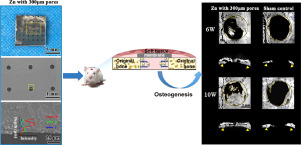当前位置:
X-MOL 学术
›
Acta Biomater.
›
论文详情
Our official English website, www.x-mol.net, welcomes your
feedback! (Note: you will need to create a separate account there.)
A pure zinc membrane with degradability and osteogenesis promotion for guided bone regeneration: In vitro and in vivo studies.
Acta Biomaterialia ( IF 9.4 ) Pub Date : 2020-02-22 , DOI: 10.1016/j.actbio.2020.02.024 Hui Guo 1 , Dandan Xia 1 , Yufeng Zheng 1 , Yuan Zhu 2 , Yunsong Liu 2 , Yongsheng Zhou 2
Acta Biomaterialia ( IF 9.4 ) Pub Date : 2020-02-22 , DOI: 10.1016/j.actbio.2020.02.024 Hui Guo 1 , Dandan Xia 1 , Yufeng Zheng 1 , Yuan Zhu 2 , Yunsong Liu 2 , Yongsheng Zhou 2
Affiliation

|
Selection of an appropriate membrane material for guided bone regeneration (GBR) is still ongoing among resorbable and nonresorbable membranes with different characteristics. The major problem with nonresorbable membranes is the inevitable secondary surgery, while resorbable polymer membranes have limitations in providing sufficient mechanical support during the bone repair period due to premature loss of mechanical strength. Pure magnesium foil has been evaluated to explore its feasibility as a resorbable GBR membrane. It exhibited better mechanical properties, whereas poor formability and fast degradation rate were noted. In light of this, pure zinc membrane was developed as a pilot research in this paper. We designed three types of pure zinc membranes: pure Zn without pores, pure Zn with 300 µm diameter and 1000 µm diameter pores, and pure titanium without pores as a control. The mechanical property, in vitro immersion tests, and MC3T3-E1 cell viability assays were tested. Moreover, in vivo behaviors of three type zinc membranes were evaluated by using a rat calvarial critical-sized bone defect model. The experimental results indicated that pure Zn membrane with 300 µm pores showed the most favorable osteogenic capability, comparable to that of titanium membrane without pores. Therefore, considering appropriate degradation rate, adequate mechanical maintenance, and profitable osteogenic capacity, metallic pure zinc is believed to be a promising candidate for barrier membranes in GBR therapy for bone regeneration, and its mechanical property can be enhanced with further alloying. STATEMENT OF SIGNIFICANCE: Metallic element zinc plays a pivotal role in the growth and mineralization of bone tissues. As a pilot research, three type of guided bone regeneration (GBR) membranes were developed in the present work: pure Zn without pores, pure Zn with 300 µm-diameter and 1000 µm-diameter pores respectively. The mechanical property, in vitro immersion tests and MC3T3-E1 cell viability assays were tested, with pure titanium without pores as a control, thereafter the in vivo performance were evaluated by using a rat calvarial critical-sized bone defect model. It indicated that pure Zn membrane with 300 µm pores showed the most favorable osteogenic capability, comparable to that of titanium membrane control, and is believed to be a promising material candidate as barrier membrane in GBR therapy for bone regeneration.
中文翻译:

具有可降解性和促进成骨作用的纯锌膜,用于引导性骨再生:体外和体内研究。
在具有不同特性的可吸收膜和不可吸收膜中,仍在为引导骨再生(GBR)选择合适的膜材料。不可吸收膜的主要问题是不可避免的二次手术,而可吸收聚合物膜由于过早失去机械强度而在骨修复期间提供足够的机械支撑方面存在局限性。已对纯镁箔进行了评估,以探索其作为可吸收GBR膜的可行性。它表现出更好的机械性能,而可成型性差,降解速度快。有鉴于此,本文开发了纯锌膜作为先导研究。我们设计了三种类型的纯锌膜:无孔的纯Zn,直径300 µm和直径1000 µm的纯Zn,不含孔的纯钛作为对照。测试了机械性能,体外浸泡测试和MC3T3-E1细胞活力测定。此外,通过使用大鼠颅骨临界大小骨缺损模型评估了三种锌膜的体内行为。实验结果表明,与没有孔的钛膜相比,具有300μm孔的纯Zn膜显示出最有利的成骨能力。因此,考虑到适当的降解速率,足够的机械维护和有利的成骨能力,金属纯锌被认为是GBR骨再生治疗中屏障膜的有前途的候选者,并且其机械性能可通过进一步合金化而增强。重要性声明:金属元素锌在骨骼组织的生长和矿化中起关键作用。作为一项先导研究,本工作开发了三种类型的引导骨再生(GBR)膜:无孔的纯Zn,分别具有300 µm直径的纯锌和1000 µm直径的孔。以无孔的纯钛为对照,测试了力学性能,体外浸泡测试和MC3T3-E1细胞活力测定,然后使用大鼠颅骨临界大小骨缺损模型评估了体内性能。这表明具有300 µm孔的纯Zn膜显示出与钛膜对照相比最有利的成骨能力,并且被认为是GBR骨再生治疗中作为屏障膜的有希望的材料候选物。在目前的工作中,开发了三种类型的引导骨再生(GBR)膜:无孔的纯Zn,分别具有300 µm直径和1000 µm直径的纯锌。以无孔的纯钛为对照,测试了力学性能,体外浸泡测试和MC3T3-E1细胞活力测定,然后使用大鼠颅骨临界大小骨缺损模型评估了体内性能。这表明具有300 µm孔的纯Zn膜显示出与钛膜对照相比最有利的成骨能力,并且被认为是GBR骨再生治疗中作为屏障膜的有希望的材料候选物。在目前的工作中,开发了三种类型的引导骨再生(GBR)膜:无孔的纯Zn,分别具有300 µm直径和1000 µm直径的纯锌。以无孔的纯钛为对照,测试了力学性能,体外浸泡测试和MC3T3-E1细胞活力测定,然后使用大鼠颅骨临界大小骨缺损模型评估了体内性能。这表明具有300 µm孔的纯Zn膜显示出与钛膜对照相比最有利的成骨能力,并且被认为是GBR骨再生治疗中作为屏障膜的有希望的材料候选物。孔径分别为300 µm和1000 µm的纯锌。以无孔的纯钛为对照,测试了力学性能,体外浸泡测试和MC3T3-E1细胞活力测定,然后使用大鼠颅骨临界大小骨缺损模型评估了体内性能。这表明具有300 µm孔的纯Zn膜显示出与钛膜对照相比最有利的成骨能力,并且被认为是GBR骨再生治疗中作为屏障膜的有希望的材料候选物。孔径分别为300 µm和1000 µm的纯锌。以无孔的纯钛为对照,测试了力学性能,体外浸泡测试和MC3T3-E1细胞活力测定,然后使用大鼠颅骨临界大小骨缺损模型评估了体内性能。这表明具有300 µm孔的纯Zn膜显示出与钛膜对照相比最有利的成骨能力,并且被认为是GBR骨再生治疗中作为屏障膜的有希望的材料候选物。此后,通过使用大鼠颅骨临界大小骨缺损模型评估体内性能。这表明具有300 µm孔的纯Zn膜显示出与钛膜对照相比最有利的成骨能力,并且被认为是GBR骨再生治疗中作为屏障膜的有希望的材料候选物。此后,通过使用大鼠颅骨临界大小骨缺损模型评估体内性能。这表明具有300 µm孔的纯Zn膜显示出与钛膜对照相比最有利的成骨能力,并且被认为是GBR骨再生治疗中作为屏障膜的有希望的材料候选物。
更新日期:2020-02-23
中文翻译:

具有可降解性和促进成骨作用的纯锌膜,用于引导性骨再生:体外和体内研究。
在具有不同特性的可吸收膜和不可吸收膜中,仍在为引导骨再生(GBR)选择合适的膜材料。不可吸收膜的主要问题是不可避免的二次手术,而可吸收聚合物膜由于过早失去机械强度而在骨修复期间提供足够的机械支撑方面存在局限性。已对纯镁箔进行了评估,以探索其作为可吸收GBR膜的可行性。它表现出更好的机械性能,而可成型性差,降解速度快。有鉴于此,本文开发了纯锌膜作为先导研究。我们设计了三种类型的纯锌膜:无孔的纯Zn,直径300 µm和直径1000 µm的纯Zn,不含孔的纯钛作为对照。测试了机械性能,体外浸泡测试和MC3T3-E1细胞活力测定。此外,通过使用大鼠颅骨临界大小骨缺损模型评估了三种锌膜的体内行为。实验结果表明,与没有孔的钛膜相比,具有300μm孔的纯Zn膜显示出最有利的成骨能力。因此,考虑到适当的降解速率,足够的机械维护和有利的成骨能力,金属纯锌被认为是GBR骨再生治疗中屏障膜的有前途的候选者,并且其机械性能可通过进一步合金化而增强。重要性声明:金属元素锌在骨骼组织的生长和矿化中起关键作用。作为一项先导研究,本工作开发了三种类型的引导骨再生(GBR)膜:无孔的纯Zn,分别具有300 µm直径的纯锌和1000 µm直径的孔。以无孔的纯钛为对照,测试了力学性能,体外浸泡测试和MC3T3-E1细胞活力测定,然后使用大鼠颅骨临界大小骨缺损模型评估了体内性能。这表明具有300 µm孔的纯Zn膜显示出与钛膜对照相比最有利的成骨能力,并且被认为是GBR骨再生治疗中作为屏障膜的有希望的材料候选物。在目前的工作中,开发了三种类型的引导骨再生(GBR)膜:无孔的纯Zn,分别具有300 µm直径和1000 µm直径的纯锌。以无孔的纯钛为对照,测试了力学性能,体外浸泡测试和MC3T3-E1细胞活力测定,然后使用大鼠颅骨临界大小骨缺损模型评估了体内性能。这表明具有300 µm孔的纯Zn膜显示出与钛膜对照相比最有利的成骨能力,并且被认为是GBR骨再生治疗中作为屏障膜的有希望的材料候选物。在目前的工作中,开发了三种类型的引导骨再生(GBR)膜:无孔的纯Zn,分别具有300 µm直径和1000 µm直径的纯锌。以无孔的纯钛为对照,测试了力学性能,体外浸泡测试和MC3T3-E1细胞活力测定,然后使用大鼠颅骨临界大小骨缺损模型评估了体内性能。这表明具有300 µm孔的纯Zn膜显示出与钛膜对照相比最有利的成骨能力,并且被认为是GBR骨再生治疗中作为屏障膜的有希望的材料候选物。孔径分别为300 µm和1000 µm的纯锌。以无孔的纯钛为对照,测试了力学性能,体外浸泡测试和MC3T3-E1细胞活力测定,然后使用大鼠颅骨临界大小骨缺损模型评估了体内性能。这表明具有300 µm孔的纯Zn膜显示出与钛膜对照相比最有利的成骨能力,并且被认为是GBR骨再生治疗中作为屏障膜的有希望的材料候选物。孔径分别为300 µm和1000 µm的纯锌。以无孔的纯钛为对照,测试了力学性能,体外浸泡测试和MC3T3-E1细胞活力测定,然后使用大鼠颅骨临界大小骨缺损模型评估了体内性能。这表明具有300 µm孔的纯Zn膜显示出与钛膜对照相比最有利的成骨能力,并且被认为是GBR骨再生治疗中作为屏障膜的有希望的材料候选物。此后,通过使用大鼠颅骨临界大小骨缺损模型评估体内性能。这表明具有300 µm孔的纯Zn膜显示出与钛膜对照相比最有利的成骨能力,并且被认为是GBR骨再生治疗中作为屏障膜的有希望的材料候选物。此后,通过使用大鼠颅骨临界大小骨缺损模型评估体内性能。这表明具有300 µm孔的纯Zn膜显示出与钛膜对照相比最有利的成骨能力,并且被认为是GBR骨再生治疗中作为屏障膜的有希望的材料候选物。











































 京公网安备 11010802027423号
京公网安备 11010802027423号